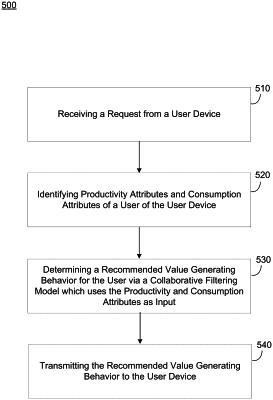| CPC G06F 16/9536 (2019.01) [G06F 16/9535 (2019.01); G06Q 10/06398 (2013.01); G06Q 10/1053 (2013.01)] | 15 Claims |

|
1. A computing system, comprising:
a network interface configured to receive a request from a user device; and
a processor configured to;
train a collaborative filtering model to identify patterns between spending behavior and secondary income generating activity via iterative execution of the collaborative filtering model on descriptions of purchases and income generating data of a community of users, inputs to train the collaborative filtering model including an indication of the descriptions of purchases for the users within the community of users and the income generating data of the users within the community of users that includes a primary income generating activity for the users within the community of users and a simultaneous secondary income generating activity for the users within the community of users;
ingest data records via an application programming interface (API), wherein the data records comprise electronic payment transaction records;
identify secondary income generating attributes of the user associated with the user device based on behavior of the user captured over time,
identify descriptions of purchases of the user based on transaction records stored in the ingested electronic payment transaction records,
execute the trained collaborative filtering model using, as an input thereto, the descriptions of purchases of the user to determine a recommended secondary employment task for the user based on a pattern between spending activity of the user and similar spending activity of other users within the community of users and secondary employment tasks performed by the other users with the similar spending activity, the executing of the trained collaborative filtering model comprises applying different recommendation weights to secondary employment tasks that the other users have only received information about versus secondary employment positions that the other users have successfully earned value from among a plurality of recommended secondary employment tasks;
identify an optimal time to send the recommended secondary employment task to the user based on the description of purchases; and
transmit the recommended secondary employment task to the user device at the optimal time via a content channel between the server and the user device.
|